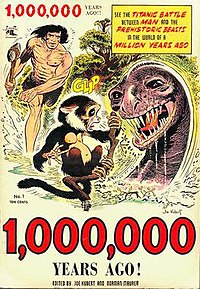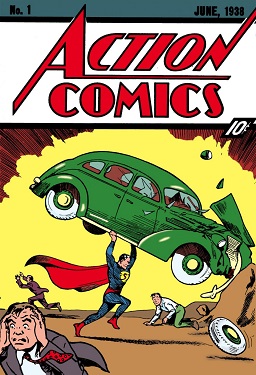
Action Comics is an American comic book/magazine series that introduced Superman, one of the first major superhero characters. The publisher was originally known as National Allied Publications, and later as National Comics Publications and as National Periodical Publications, before taking on its current name of DC Comics. Its original incarnation ran from 1938 to 2011 and stands as one of the longest-running comic books with consecutively numbered issues. The second volume of Action Comics beginning with issue #1 ran from 2011 to 2016. Action Comics returned to its original numbering beginning with issue #957.

Quality Comics was an American comic book publishing company which operated from 1937 to 1956 and was a creative, influential force in what historians and fans call the Golden Age of Comic Books.

Andrew Kubert is an American comics artist, letterer, and writer. He is the son of Joe Kubert and brother of Adam Kubert, both of whom are also artists, and the uncle of comics editor Katie Kubert.
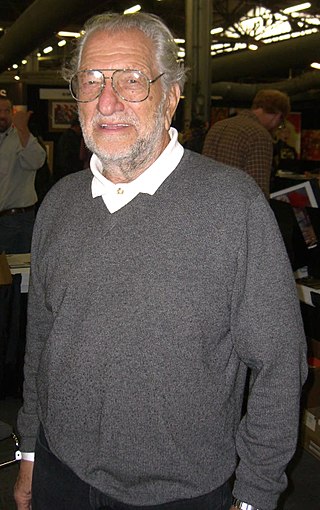
Joseph Kubert was a Polish-born American comic book artist, art teacher, and founder of The Kubert School. He is best known for his work on the DC Comics characters Sgt. Rock and Hawkman. He is also known for working on his own creations, such as Tor, Son of Sinbad, and the Viking Prince, and, with writer Robin Moore, the comic strip Tales of the Green Beret. Two of Kubert's sons, Andy Kubert and Adam Kubert, themselves became recognized comic book artists, as did Andy's daughter Emma Kubert and many of Kubert's former students, including Stephen R. Bissette, Amanda Conner, Rick Veitch, Eric Shanower, Steve Lieber, and Scott Kolins. Kubert's other grand-daughter, Katie Kubert, became an editor for both DC and Marvel Comics.
Godzilla has appeared in a range of comic books that have been published in Japan and the United States.

Adam Kubert is an American comics artist known for his work for publishers such as Marvel Comics and DC Comics, including work on Action Comics, Astonishing Spider-Man & Wolverine, The Incredible Hulk, Ultimate Fantastic Four, Ultimate X-Men, and Wolverine.

Superman is an ongoing American comic book series featuring the DC Comics superhero Superman as its protagonist. Superman began as one of several anthology features in the National Periodical Publications comic book Action Comics #1 in June 1938. The strip proved so popular that National launched Superman into his own self-titled comic book, the first for any superhero, premiering with the cover date summer 1939. Between 1986 and 2006 it was retitled, The Adventures of Superman, while a new series used the title Superman. In May 2006, it was returned to its original title and numbering. The title was canceled with issue #714 in 2011, and was relaunched with issue #1 the following month which ended its run in 2016. A fourth series was released in June 2016 and ended in April 2018, while the fifth series was launched in July 2018 and ended in June 2021. The series was replaced by Superman: Son of Kal-El in July 2021, featuring adventures of Superman's son, Jon Kent. A sixth Superman series was released in February 2023.

Superman: The Man of Steel was a monthly American comic book series that ran for 136 issues from 1991 to 2003, featuring Superman and published by DC Comics. As a result of introducing this series alongside its already existing titles, DC Comics was able to publish a new Superman comic each week. Included in these 136 issues were two special issues: #0 and #1,000,000, which were tie-ins to Zero Hour: Crisis in Time and DC One Million, respectively.
The Grand Comics Database (GCD) is an Internet-based project to build a database of comic book information through user contributions. The GCD project catalogues information on creator credits, story details, reprints, and other information useful to the comic book reader, comic collector, fan, and scholar. The GCD is a 501(c)(3) nonprofit organization incorporated in Arkansas.

Tarzanesque is a term created by Frenchman Francis Lacassin used to describe characters in comic books inspired by Tarzan. A tarzanesque character resembles Tarzan in his physical resourcefulness, within a line of action that includes an adventurous life in the jungle, the gift of understanding and being understood by animals, contact with lost civilizations and courage combined with the ability to deal with nature. The creation of such characters may have been propitiated by the success that Tarzan had achieved since his appearance in literature in 1912, culminating with the release of daily comic strips in 1929, which paved the way for a genre that combined the allure of the unknown environment, the need for the archetypal characteristics of the hero and the popularity of access.
St. John Publications was an American publisher of magazines and comic books. During the 1947-1958 existence of its comic-book division, St. John established several industry firsts. Founded by Archer St. John, the firm was located in Manhattan at 545 Fifth Avenue. After the St. John comic books came to an end in 1958, the company continued to publish its magazine line into the next decade. Flying Eagle Publications was a magazine affiliate of St. John Publications. Comic book imprints included Approved Comics, Blue Ribbon, and Jubilee Publications.

Our Army at War was an American comic book anthology published by DC Comics that featured war-themed stories and featured the first appearances of Sgt. Rock and Enemy Ace. The series was published from August 1952 to February 1977, then was renamed Sgt. Rock in March 1977, continuing the numbering sequence of Our Army at War.
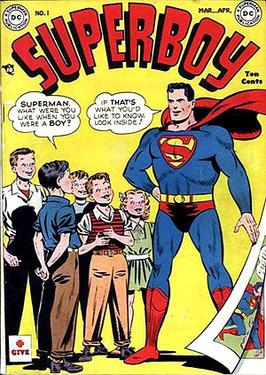
Superboy is the name of several American comic book series published by DC Comics, featuring characters of the same name. The first three Superboy titles feature the original Superboy, the underaged version of the legendary hero Superman. Later series feature the second Superboy, who is a partial clone of Superman.
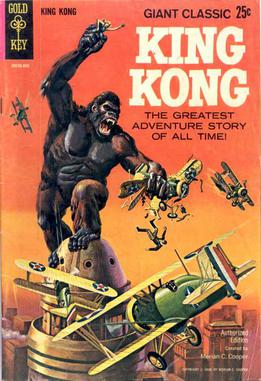
Throughout the decades King Kong has been featured in numerous comic book publications from numerous publishers.
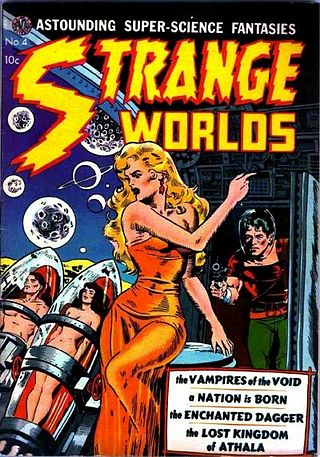
Strange Worlds is an American science-fiction anthology comic-book series published by Avon Comics over 15 issues between November 1950 and September/October 1955. The series ran in two sequences. Issues #1–10 ran cover-dated November 1950 to November 1952. No issues #11–17 were released, and the series began publication again with #18, having taken over the numbering of the defunct Avon comic Eerie. This second sequence ran through issue #22.

Tarzan, a fictional character created by Edgar Rice Burroughs, first appeared in the 1912 novel Tarzan of the Apes, and then in 23 sequels. The character proved immensely popular and quickly made the jump to other media, including comics.

Nestor P. Redondo was a Filipino comics artist best known for his work for DC Comics, Marvel Comics, and other American publishers in the 1970s and early 1980s. In his native Philippines, he is known for co-creating the superheroine Darna.

The Real Ghostbusters is a comic series spun off from The Real Ghostbusters animated series. Versions were published by Marvel UK and NOW Comics. Publication of the series began on March 28, 1988.
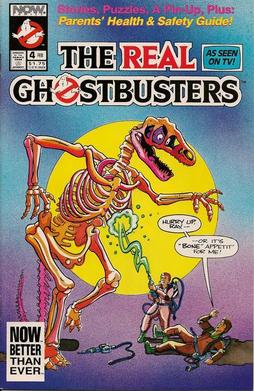
The Ghostbusters franchise spawned various comic books published by various comic book companies through the years starting in 1988 and continuing to the present day. These comics have ranged from being based on The Real Ghostbusters animated series, to the 1984 film.
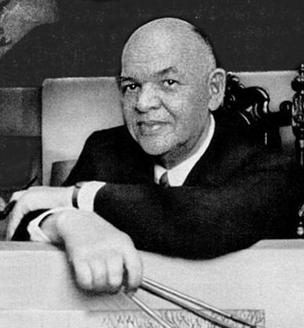
Elmer Cecil Stoner was an American comics artist and commercial illustrator. Stoner was one of the first African-American comic book artists, and is believed to have created the iconic Mr. Peanut mascot. He produced pencil art for the first issue of Detective Comics, published by National Comics Publications, and worked for a variety of other golden age companies such as Timely Comics, Street & Smith, EC Comics, Fawcett Comics, and Dell Comics. Near the end of his life, Stoner was also a spokesman for Gordon's Gin.

